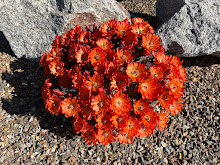Last year, at my local nursery, they had some floating islands in their water garden. What a great idea. They were made out of some kind of dense black material with a hole in the center in which you could put a pot. The price tag was enough to get me thinking about how I could replicate something like this at little or no cost. Scouting around in the garage I came across the perfect materials and in no time I had three of them floating on the water. If you re at all interested directions on how I made them follow.
They are ideally suited to plants which like to be submerged in the water. I have two stock tank ponds, one which enjoys full sun and one in a more shady location. In the smaller of the two tanks I have golden variegated Japanese sweet flag, Acorus gramineus 'Ogon' and Horsetail, Equesetum sp. both in floating planters.
There are several advantages to having these floating islands.They make for a much tidier appearance than plant pots standing on bricks and they provide a perfect resting spot for wildlife. What frog doesn't like to float around the pool on his personal raft.
So what did I use and how did I put it together? Firstly I cut some circles out of this solid insulation foam cutting an inner circle the diameter of the pot I wanted to use.I happened to pick up a sheet of this at a garage sale. I knew it would come in handy one day!
My plan was to cover them with the heavy material used to cover the silt fencing. We happened to have some of that from when we built the house and it was a matter of removing it from the wire. I cut a circle of the material enough to fold right over the foam. I then pinned and stapled it down. It is not a permanent solution but it has held up well and means that if I need to redo the material it is easy enough to pull out.
I cut slits in the material and removed a lot of the excess so that there wasn't too much bulk.
Then slipped the pot into the hole pinning down the material. All ready to plant.
Any lightweight foam would do and there are probably a number of options for cover material. Black seems to work best with the dark water surface.
These plants will never be high and dry if the water level falls.
Publication day for Gardens of Texas!
11 hours ago




































8 comments:
Looks like a great solution. Not only neater, but also gives changing views as the wind blows the pots around.
Wonderful idea and execution!!!! Thanks for sharing!
Now that is clever!!
Nice! This could be the solution to my problem of raccoons always knocking my pots off the bricks that they're standing on.
I absolutely love how willing you are to cobble together a perfectly workable less expensive solution to some of the "convenience" products on offer. This makes me want a pond more than ever, of only to try out your idea. Which reminds me - it seems I recall another tutorial you gave on making hypertufa? I'm off to search!
The frog photo alone makes me want both a stock tank pond and float-supported plants!
Such a clever idea, Jenny! Thanks for the tutorial.
I need to do this. The &*&&^%$&^ raccoons have managed to kill the papyrus and water lilies you and Pam shared with me. And BTW, your camera is sort of kind of working on the raccoons....enough to know that they are jerks in groups of 3 and like to actually crawl into the bird water dish to frolic at 3 AM. I am gonna try video next and see if I have more luck.
Post a Comment